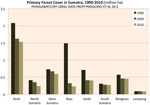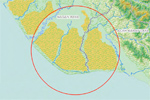
Rainforest in the Leuser Ecosystem Area
The Indonesian province of Aceh on the western tip of the island of Sumatra may be preparing to lift the protected status of key areas of lowland rainforest potentially ending its bid to earn carbon credits from forest conservation and putting several endangered species at increased risk, according to reports.
Under a draft plan developed by the Aceh parliament’s spatial planning committee, some 71,857 hectares of protected areas will lose their protected status and be turned over for logging, mining, and conversion for plantations. While the area represents two percent of Aceh’s forests, which presently cover 55 percent of the province’s land mass, it includes some of Sumatra’s increasingly rare lowland forests. Aceh has the most extensive forest cover left in Sumatra, where vast swathes of forest — 40 percent of its primary forests and 36 percent of its total forest cover since 1990 — have been cleared for pulp and paper plantations, oil palm estates, and agriculture.

The draft plan is a significant departure from the plan proposed by Aceh’s last governor, Yusuf Irwandi, who championed himself as a conservationist. Irwandi’s plan — which was never passed — called for increasing forest cover to 68 percent of the province through strict conservation and reforestation. The new plan targets 45 percent, including reactivating abandoned logging concessions.
The former governor’s plan was driven by his interest in earning carbon credits under Reducing Emissions from Deforestation and Degradation (REDD+), a opposed mechanism that aims to compensate tropical countries for protecting and restoring forests. But REDD+ has failed to develop as hoped, undercutting the market for, and value of, forest-conservation based credits. Now one of the first REDD+ projects in the world — located in Aceh’s Ulu Masen — appears to be on the chopping block, according to a report in the Sydney Morning Herald.
“Another wilderness area, Ulu Masen, which was slated to become a 735,000-hectare preservation area to prevent carbon emissions, is also not recognized under the spatial plan,” wrote Michael Bachelard for the newspaper.
Part of the motivation for the change may be political, according to a local government source who spoke to Mongabay.com on the condition of anonymity.
“The 68 percent figure was in the draft spatial plan prepared by the Irwandi administration, however the government reform inside Aceh needed to achieve this goal never took place during his term,” the official said. “Now what we are left with is a team that is 100% anti anything that slightly resembles Irwandi, and a team of bureaucrats who have no faith in REDD delivering any funding and are preparing to launch major deforestation and [road] projects in the name of ‘community development’ which in reality is simply driven by a small number of large businesses.”
Environmentalists say some of the areas set to be excised from reserves under the revised spatial plan would go to mining, palm oil, and logging companies. The Aceh branch of WAHLI, a Indonesian environmental group, said that Acehnese civil society groups are reviewing the proposed changes and matching them with road development projects, oil palm plantations, and mining concessions.
“We fear that these changes are influenced by [business] interests,” TM Zulfikar, Executive Director of Walhi Aceh, told Mongabay-Indonesia. “We encourage the committee to open the spatial plan to the public.’
But Aceh’s Head of Planning Department of Forestry and Plantation, Saminuddin B. Tou, denied that mining and palm oil interests are influencing the process. He said some of the areas have already been converted and developed despite being designated as protected by the central government’s Ministry of Forestry.
“We checked the boundary of the Wildlife Reserve Rawa Singkil on the ground and found is a discrepancy between the Ministry of Forestry map and the conditions in the field,” Saminuddin told Mongabay-Indonesia. “When the boundaries of Wildlife Reserve were set in the year of 2000, there were already settlements in the town of Subulussalam and oil palm plantations leases in the conservation area. This is our chance to issue a concession areas and settlements which were already established in Rawa Singkil Wildlife Reserve.”
However the draft spatial plan also proposes opening up parts of the Leuser Ecosystem Area, an zone renowned for its biodiversity — including populations of critically endangered tigers, orangutans, rhinos, and elephants — for concessions. Leuser has been designated as a “National Strategic Area” by the central government, requiring its protection and “sustainable management”. Yet Aceh Governor Zaini Abdullah recently transferred control of the Leuser ecosystem’s independent management authority to the province’s Department of Forestry, which is “traditionally pro-development” according to the Sydney Morning Herald report, raising questions about the long-term commitment to protecting the area. Leuser has already been a source of tension between the central government and the government of Aceh. Former Governor Irwandi, despite his green reputation, in 2011 granted an oil palm development permit in the Leuser’s Tripa peat swamp in violation of the central government’s moratorium on new concessions in the area. That palm oil company’s permit was later revoked, but not before the area was heavily damaged.
Ultimately if Aceh’s proposed changes to its spatial plan are deemed too radical, some could be reined in the central government. Furthermore, local opposition could make it difficult for excessive concession development in areas used traditionally by communities. Aceh still has extensive forest cover partly due to opposition in the form of an insurgency by the Free Aceh Movement (Gerakan Aceh Merdeka – GAM), which fought against the Indonesian government from 1976-2005. Among GAM’s grievances was natural resource extraction by outsiders.

Nonetheless environmentalists are deeply concerned about the proposed spatial plan.
“In Indonesia, most of the good forest is gone except Aceh and Papua,” Mike Griffiths, a former coordinator for the Leuser Ecosystem Management Authority told Sydney Morning Herald. “[Now, in Aceh] they are planning, sooner or later, to knock down a quarter of their forests, most of them in the lowland areas.”
“If this happens, we’ll see the extinction of all the charismatic species in 10 to 20 years.”
Related articles
Aceh revokes permit for controversial oil palm plantation in Sumatra
(10/01/2012) Aceh Governor Zaini Abdullah officially revoked the business permit for a company developing a controversial oil palm plantation in a peat swamp in Sumatra, concluding a case that had tested Indonesia’s commitment to a moratorium on new concessions in peatlands and rainforests.
Rainforests decline sharply in Sumatra, but rate of deforestation slows

(08/28/2012) The extent of old-growth forest in Sumatra shrank by 40 percent over the past 20 years, while overall forest on the Indonesian island declined by 36 percent, finds a comprehensive new satellite-based assessment published in Environmental Research Letters. The research, conducted by an international team led by Belinda Arunarwati Margono of South Dakota State University and Indonesia’s Ministry of Forestry, reveals the dire condition of Sumatra’s once extensive rainforests. Overall Sumatra lost 7.5 million hectares of forest between 1990 and 2010, of which about 2.6 million hectares was primary forest. The bulk of forest loss occurred in secondary forests that had been previously degraded by logging.
Indonesia to investigate contested oil palm concession as governor loses election in Sumatra
(04/12/2012) A high ranking Indonesian official is investigating the controversial grant of an oil palm concession within an area of protected peat forest in Aceh on the island of Sumatra, reports the Jakarta Globe.
Governor of Aceh who signed palm oil permit: plantation in Tripa “morally wrong”

(04/05/2012) The former governor of Aceh, Irwandi Yusuf, told The Sydney Morning Herald today that an oil palm plantation he approved was “not wrong legally, but wrong morally.” Irwandi, who is currently seeking re-election, signed off on the hugely controversial plantation in deep peat forest last August, but the issue came to a head this week as satellite images showed a dozen fires burning in the concession area known as Tripa. Environmental groups, which are running an online campaign, warn that the burning is imperiling an important population of Critically Endangered Sumatran orangutans (Pongo abelii).
REDD may not be enough to save Sumatra’s endangered lowland rainforests

(11/24/2009) A prominent REDD project in Aceh Indonesia probably won’t be enough to save Northern Sumatra’s endangered lowland rainforests from logging and conversion to oil plantations and agriculture, report researchers writing in Environmental Research Letters. The study highlights the contradiction between the Ulu Masen conservation project; which involves Flora and Fauna International, Bank of America, and Australia-based Carbon Conservation, a carbon trading company and the continuing road expansion, and establishment of oil palm plantations in the region.
40% of lowland forests in Sumatra and Indonesian Borneo cleared in 15 years
(11/10/2009) Forty percent of lowland forests in Sumatra and Kalimantan (Indonesian Borneo) were cleared from 1990 to 2005, reports a new high resolution assessment of land cover change in Indonesia.